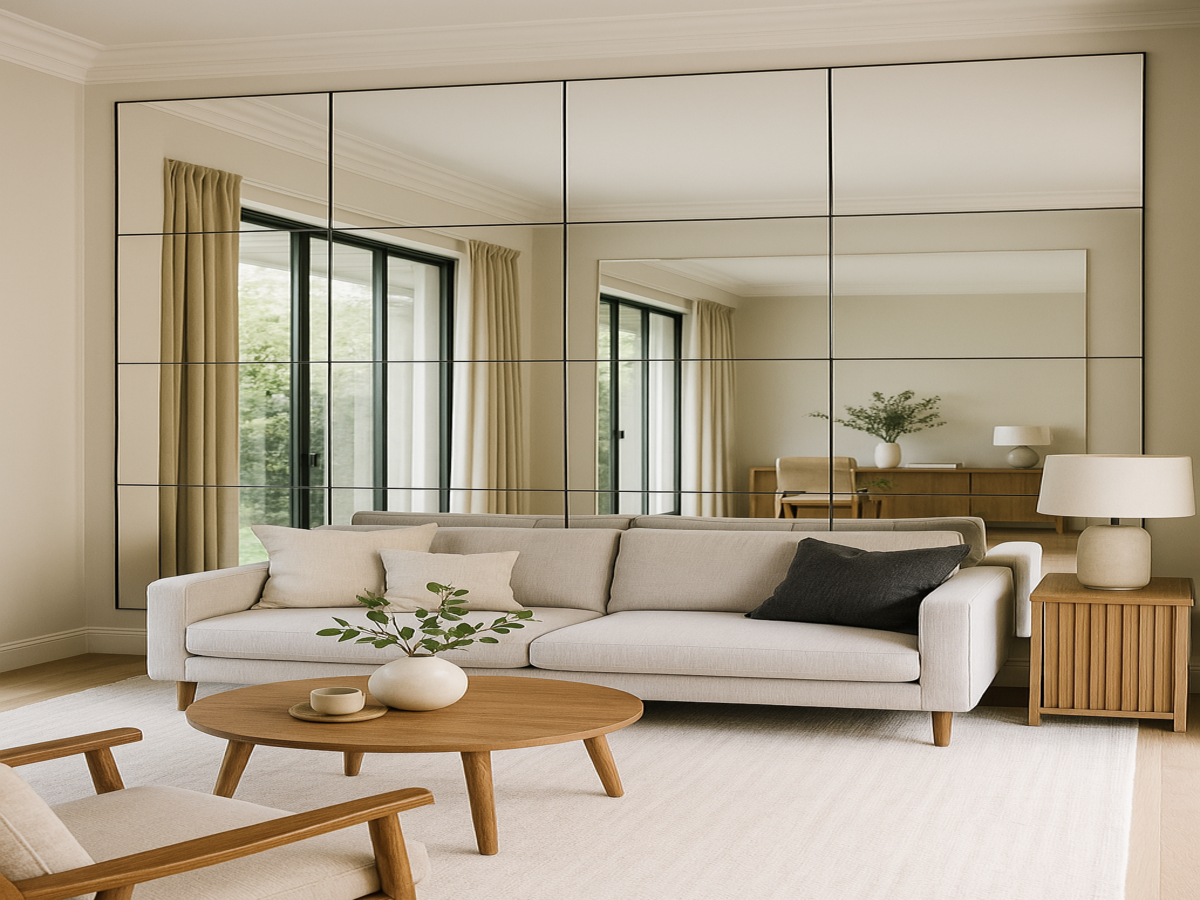
Mirrors are more than just reflective surfaces, they’re powerful design tools that can transform the feel of a space. Mirror wall panels add depth, amplify light, and lend a sleek, modern appeal to interiors. In offices, gyms, hotels, and retail spaces, they enhance spatial perception, boost natural light, and create a polished, high-end look.
More than an aesthetic feature, mirror wall panels also support functional goals from improving visibility in low-light areas to helping smaller spaces feel more expansive. Whether integrated into a full commercial refurbishment or part of a targeted office fit out, they deliver both beauty and utility.
Why Are Mirror Wall Panels So Popular in Commercial Interiors?
Mirror wall panels are large, fixed mirror installations that cover entire walls or targeted sections of a room. Unlike standard framed mirrors, these panels are seamless and built to blend into the space enhancing architectural lines and creating the illusion of added depth.
These panels are now a common feature in:
- Modern office interiors (especially in meeting rooms and executive suites)
- Commercial gyms and wellness centres
- Hotel lobbies and corridors
- Boutique retail spaces and salons
Their popularity stems from their versatility available in tinted, antiqued, or custom finishes, mirror wall panels can complement almost any design scheme, from sleek minimalism to classic opulence.
Functional Benefits:
- Reflect light to brighten dim areas.
- Make small or narrow rooms feel larger.
- Add sophistication and visual intrigue.
- Support brand image with premium finishes.
Where Can You Use Mirror Wall Panels?
1. Offices and Workspaces
Mirror panels enhance brightness in closed meeting rooms and add spaciousness to reception areas. They’re ideal for modern office fit outs where light optimisation and design cohesion are priorities. Installed in boardrooms, lift lobbies or breakout zones, mirrors reflect professionalism and help maximise natural light.
2. Commercial Gyms and Wellness Spaces
In gyms, mirror wall panels are essential — allowing clients to check posture and movement while also making workout zones feel open and energetic. Placing them strategically in yoga studios, weight rooms, or pilates areas amplifies both aesthetics and functionality. Their easy-clean surfaces also suit high-use environments.
3. Hotels and Hospitality Spaces
Hotel lobbies, corridors, and lounges benefit immensely from the luxury and depth that mirror panels provide. They can create a sense of grandeur in small boutique hotels or add brightness to windowless spaces. Antiqued and bevelled mirrors work particularly well in premium hospitality environments.
4. Retail Stores and Salons
In retail, mirror wall panels create the illusion of space and encourage product interaction. Fitting rooms, feature walls, and even ceiling installations can influence shopper perception — making spaces feel curated and stylish. In hair salons or beauty clinics, mirrors improve lighting and elevate the customer experience.
5. Living rooms
Mirror wall panels are a game-changer for living rooms, especially in homes with limited space. By reflecting the surroundings, they create a sense of depth, making the room feel more expansive. Placing them behind a sofa, on an accent wall, or opposite a window allows light to bounce across the room, instantly brightening the space. This not only enhances the overall look but also fosters a more welcoming and comfortable environment for gatherings, relaxation, and daily living.
What Types of Mirror Wall Panels Should You Consider?
1. Frameless vs. framed panels
Frameless panels offer a clean, modern look perfect for contemporary offices, gyms, and wellness studios. Framed mirrors add definition and are ideal in boutique hospitality or heritage refurbishments.
2. Tinted and Decorative Finishes
Bronze or grey tints create a sophisticated, ambient feel — ideal for gyms, hotels, or lounges.
Etched or frosted designs offer privacy while maintaining light flow, useful in open-plan offices or shared commercial areas.
3. Bevelled, Antiqued and Custom Designs
- Bevelled edges catch light beautifully, adding dimension.
- Antiqued finishes bring vintage charm to high-end interiors.
Custom designs are perfect for branded environments, allowing tailored shapes, logos or lighting integration.
Installation Process – What You Need to Know
1. Surface Prep & Positioning
Ensure the surface is smooth, clean, and free from grease. Use backing boards for rough walls and plan exact placement with a spirit level for a symmetrical look — critical in formal office or hospitality settings.
2. DIY vs. Professional Installation
While some modular panels are DIY-friendly, large-scale installations or custom-cut panels are best left to professionals. For example, during a complete office refurbishment or commercial redesign, professional installers will ensure secure mounting and code compliance especially for high-traffic or public-facing areas.
Best Practices for Safety & Longevity
- Use mirror adhesive or mounting clips for stability.
- Wear gloves and use suction lifters for safe handling.
- Choose shatter-resistant panels for gyms or retail spaces.
Maintenance Tips to Keep Mirror Panels Flawless
1. Streak-Free Cleaning
Spray cleaner onto a microfiber cloth rather than directly onto the mirror to prevent edge damage. A mix of distilled water and vinegar or alcohol-based cleaner works well.
2. Scratch Prevention
Avoid abrasive cloths or harsh chemicals. Use a soft microfiber cloth and avoid pressing furniture or equipment directly against the mirror surface.
3. Long-Term Durability
- Ensure adequate ventilation in humid areas like gym shower zones.
- Avoid prolonged direct sunlight exposure.
- Schedule occasional professional inspections for large installations.
How Much Do Mirror Wall Panels Cost?
The cost of mirror wall panels can vary significantly depending on the size of the installation, the type of mirror finish, and whether it’s a custom or off-the-shelf solution.
Here’s a general breakdown to help you estimate costs for your office or commercial space:
| Type of Mirror Wall Panel | Average Cost (Supply & Install) |
| Standard Clear Mirror Panels | £120 – £180 per m² |
| Tinted Mirror Panels (Bronze, Grey) | £150 – £220 per m² |
| Bevelled or Antiqued Mirror Panels | £180 – £300 per m² |
| Custom Cut or Branded Designs | From £250+ per m² |
Installation-only costs (for panels supplied separately) typically range from £50–£100 per m², depending on access, wall condition, and complexity.
Factors That Can Affect Pricing
1. Size & Quantity: Larger walls or full-room installations benefit from scale but increase material and labour costs.
2. Wall Preparation: Uneven surfaces may need additional boarding or prepping before installation.
3. Custom Features: Etching, backlighting, logos, and special finishes can increase the cost.
4. Location & Access: Installations in multi-storey buildings, gyms with tight access, or heritage sites may incur higher labour fees.
For example:
- A small office meeting room feature wall (approx. 5m²) in standard mirror might cost £600–£900.
- A fitness studio wall with safety-backed, tinted mirrors across 12m² could range from £1,800–£2,600.
- A hotel lobby with antique mirror cladding might cost £3,000+, depending on design detail.
FAQs
Mirror wall panels and mirror cladding are closely related but not exactly the same.
Learn More: Mirror Wall Cladding vs. Mirror Wall Panels
Yes, when using safety-backed or tempered mirrors with proper installation, they’re safe and durable in active environments.
Absolutely — logos, shapes, and custom etching are all possible for brand-aligned spaces.
Yes. They reflect both natural and artificial light, improving brightness without added energy costs.
Yes! Mirror wall panels are one of the most effective ways to create the illusion of a larger space. By reflecting light and surroundings, they visually extend a room, making it feel more open and expansive. This is particularly useful in smaller spaces like apartments, narrow hallways, or compact offices, where maximizing space is essential. When strategically placed, such as opposite windows or along long walls, mirrors can amplify both natural and artificial light, adding brightness and depth.
Yes, as long as proper moisture-resistant backing and ventilation are provided.
With proper care, installation, and cleaning, they can last decades without losing clarity or function.














